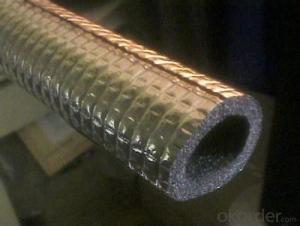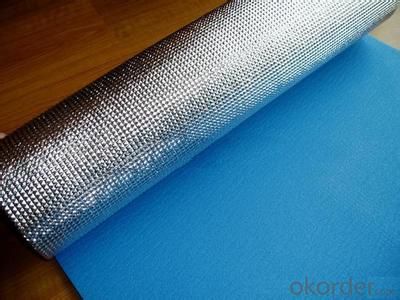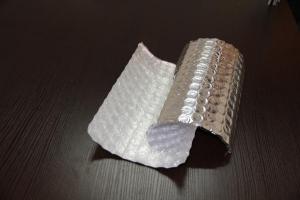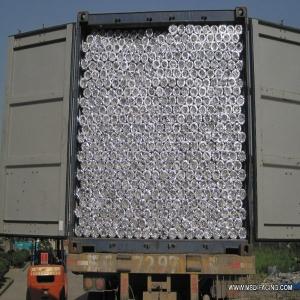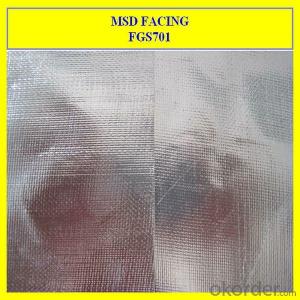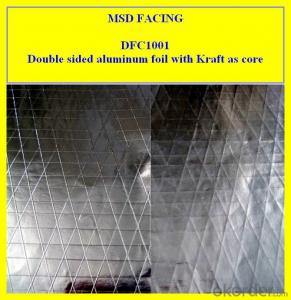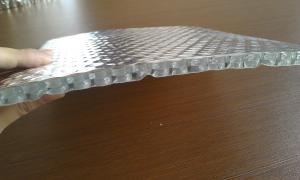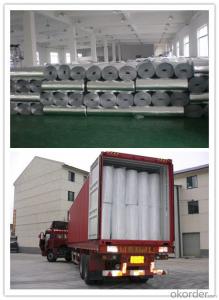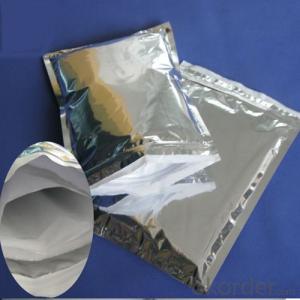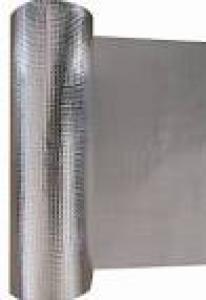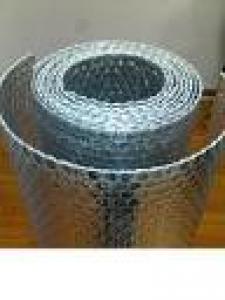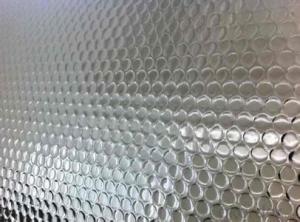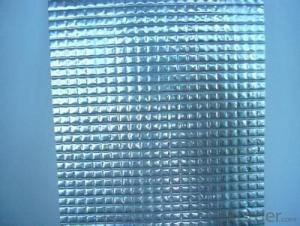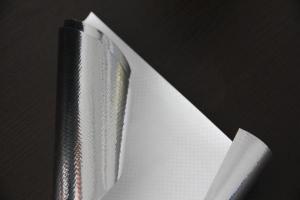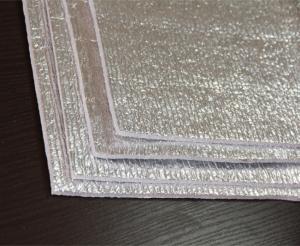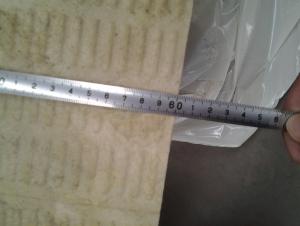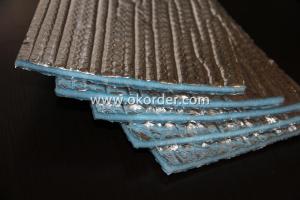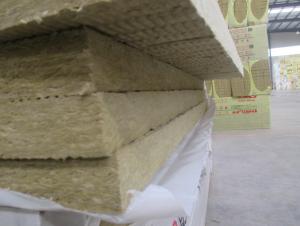Roofing Insulation Disc - Aluminum Foil Coated Bubble Insulation Type 7
- Loading Port:
- Shanghai
- Payment Terms:
- TT OR LC
- Min Order Qty:
- 10000 m²
- Supply Capability:
- 100000 m²/month
OKorder Service Pledge
OKorder Financial Service
You Might Also Like
Bubble Insulation Benefits:
Reflects 96% of radiant heat
Non-toxic / Non-carcinogenic
Does not require protective clothing or respirators to install
Durable and lightweight
Does not compress, collapse or disintegrate
Vapor and radon retarder
Easy to cut and install
Permanent and maintenance-free
Does not provide a growth medium or nutritive value for fungus, insects, or rodents
Does not support the growth of mold or mildew
Not affected by moisture or humidity
Lowers heating and cooling costs year round
Bubble Foil Application:
Metal & Steel Buildings
Homes
Roof Underlayments
Cathedral Ceilings
Crawl Spaces
Hot Water Heaters
Basement Walls
Floors
Garage Doors
Concrete slabs
Driveway snow melts
Pole barns
Post frame buildings
Poultry barns
Animal kennels
Temperature sensitive storage areas
Air Bubble Foil Insulation Tech Data:
Material Structure: AL/Bubble/AL | ||
Bubble Size:D10mm*H 4mm(10*2.5/10*4/10*6/20*7/25*10)choose the bubble size | ||
Bubble Weight:0.13kg/m2 ( can be customized ) | ||
Roll Width:1.2m (lenth can be customized) | ||
PROPERTIES | TEST DATA | UNIT |
Thickness | 3.5-4 | mm |
Weight | 250 | g/m2 |
Emissivity | 0.03-0.04 | COEF |
Thermal conductivity | 0.034 | w/m0 |
Apparent Density | 85 | kg/m3 |
Reflectivity | 95-96 | % |
Water Vapour Transmission | 0.013 | g/m2kpa |
Corrosion | doesn't generate | |
Tensile Strength(MD) | 16.98 | Mpa |
Tensile Strength(TD) | 16.5 | Mpa |
- Q: the noise when it rains is very loud. can I place an insulation material under the polycarbonate roof to reduce noise? Thanks
- Sure, depending on the roof space anyway.
- Q: As opposed to other roof structures, such as Mansard or Hipped roofs. If so, is it because there is a lesser distance between the internal heat source and the roof?
- Hm. Tough one. Could be. I would think because there is less surface area.
- Q: Does snow on the roof help or hurt my heating bill?
- I would think that the snow on your roof actually helps to insulate your house more. Think about dog sled teams in the far north the dogs dig themselves under the snow to stay warm at night. Also I have taken winter survival trips while I was in Canada and was taught that snow acts as an insulator. I think it helps.
- Q: Why is the most insulation needed in ceilings or roofs? Just wanted to know
- well insulation in general is to keep the inside temperature different than the outside. since hot air usually rises, i think it is to keep warm air form escaping in winter. also you don't usually have a heater in the attic, or air conditioning so insulation will keep the air in the attic from having an effect on the air within the house. that is my idea as to why
- Q: Foam and the new building technolodgy's are coming to New Orleans. The rebuilding is causing New Orleans to be the "Greenest City in America". Energy Efficiency and the proper buiilding techniques tak hold.
- And the question is??
- Q: Hi, I have got a physics question and was just wondering about it.. Can someone pls tell me how does roof insulation work? how is it effective? How does the insulation changes the heat circulation and transfer inside a house?I know that the insulation prevents radiation from the sun and overheating.. but any more details about radiation, convection and conduction of heat pls?
- Well insulation makes a dead air space (air is stagnant). Since the air is not moving the transfer of hot and cold is slowed down considerably. But since you have to create cross ventilation to reduce rotting in wood and the build up of explosive gasses. Its a crap shoot that it even does any good. Radiation is heat so that's covered by the dead air space. Convection is usually not an issue with the cross venting. Also for conduction the insulation should slow it down considerably.
- Q: Can you put fiberglass insulation on the under side of roof tiles in the loft in the house?
- I would be concerned that this may cause moisture to form between the roofing and the insulation. They make a special foam panel that fit underneath the roofing in between the roof rafters. They allow air to flow from the eave to the roof's ridge.
- Q: Finally remembering to do so, before my family and I left the house for approximately 4 hours, I turned off the heat before leaving. When we came home I turned it back on, but was shocked to see that the temperature had dropped 4 degrees in that time. 4 degrees in just under 4 hours seems like a lot of heat loss, does it not? I've seen the insulation in our roof and it's just that sawdust looking stuff spread everywhere. I feel like I'm paying a lot of unnecessary dollars for heating: the air does kick on every hour or two and we keep the thermostat at 68.Is it reasonable for me to talk to my landlord about this problem and getting better insulation in the ceiling, and maybe in the roof? (the master bedroom, on the far corner of the house, is always 2-3 degrees below the rest of the house). Are my expectations to not lose a degree of heat or more per hour unreasonable? Would a typical landlord consider this a problem worth discussing?
- The roof (assume pitched) doesn't need insulating it's above the attic above the ceilings of all the rooms that need 12 inch of mineral wool insulation to stop heat loss (you may have less thickness not all insulation is to the correct standards) Also if as I suspect the walls of your home are timber with shiplap (and not solid brick / cavity walls) they also require insulation top up. From a google search there is state wide Government grants for insulating homes, could be available in your state? using blown insulation to walls/ceilings. If you decide to install it yourself the payback is excellent -in 12 months depending on fuel cost and what existing insulation (from your description minimal) The landlord could be entitled to increase your lease costs if he takes the work on as he has greatly improved the thermal insulation which will reduce your heating costs and make his property more valuable to lease.
- Q: i have about 200 sq ft of odd shaped polystyrene foam (rigid) insulation between 3" and 5" thick. it's leftover from installing a flat roof on a commercial building. creative ideas anyone? grind it and use it as attic insulation in a home?thanks.
- put an AD and sell it as material for Accoustic sound proofing,
- Q: Above the trailer roof is a metal pitched roof with no soffit and lots of air-flow. I plan to recess the insulation 6" to allow airflow. There is a suggestion that I need a vapor barrier. If I use a vapor barrier, won’t water collect between the roof and the barrier. I was thinking if using strapping crosswise every 4” to act as a channel for water runoff. Any ideas?
- The roof is already a vapor barrier, you won't need 2.
Send your message to us
Roofing Insulation Disc - Aluminum Foil Coated Bubble Insulation Type 7
- Loading Port:
- Shanghai
- Payment Terms:
- TT OR LC
- Min Order Qty:
- 10000 m²
- Supply Capability:
- 100000 m²/month
OKorder Service Pledge
OKorder Financial Service
Similar products
Hot products
Hot Searches
Related keywords
